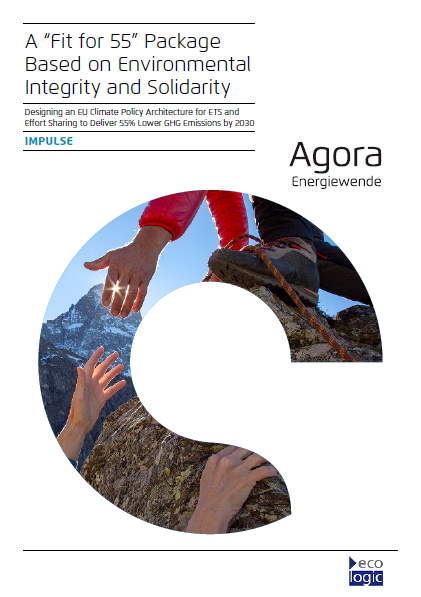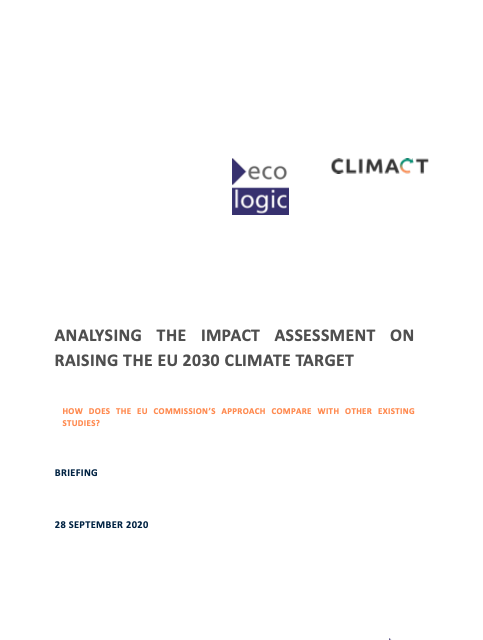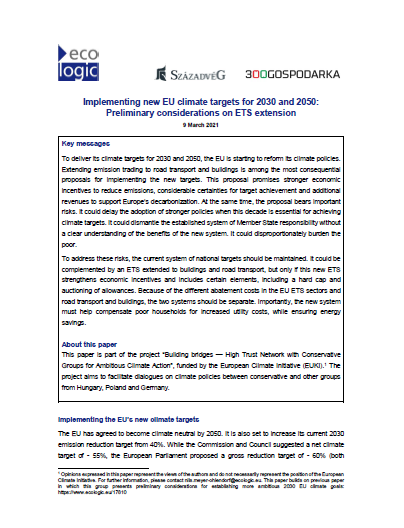A "Fit for 55" Package Based on Environmental Integrity and Solidarity
Designing an EU climate policy architecture for ETS and effort sharing to deliver 55% lower GHG emissions by 2030
- Publication
- Citation
Agora Energiewende and Ecologic Institute (2021): A "Fit for 55" package based on environmental integrity and solidarity: Designing an EU climate policy architecture for ETS and effort sharing to deliver 55% lower GHG emissions by 2030, Berlin: Agora Energiewende.
The EU has raised its climate target for 2030 to at least -55 % and is now debating how to reform its climate policy architecture so that it can reach it. In a new study, Agora Energiewende and Ecologic Institute sketch a "Fit for 55" package that can ensure both environmental integrity and solidarity. It investigates four options how to regulate heating and transport emissions, focusing in particular on the pros and cons of expanding emissions trading to these sectors. The paper makes the case for a smart mix of EU-level carbon pricing and companion polices.
These are the report's key findings.
- The EU's "Fit for 55" climate policy architecture must guarantee environmental integrity and address solidarity. To guarantee both, the architecture must have a robust compliance mechanism. Whatever EU climate policy architecture is chosen, each ton of CO2 must be governed by the ETS or the Effort Sharing mechanism. At the same time, the target achievement must be a collective endeavor that supports lower-income Member States and poorer households.
- There are different options for strengthening the ETS and/or effort sharing while ensuring the environmental integrity of the -55% target. A standalone ETS for transport and/or buildings, an enlarged EU ETS, or tightened effort sharing are all options that could work, and each has their pros and cons. The important thing is to define who is accountable for reducing emissions, and who will be responsible if targets are not met. When emissions trading serves as the central compliance mechanism, prices must be allowed to rise as high as necessary to reach the emission reduction target – which means not introducing a price cap.
- A carbon price works better if it is supported by companion policies. This holds especially true for households and transport. Companion policies in these sectors guide investment decisions and drive innovation, while the carbon price addresses the use of existing cars and heating systems. Strengthening EU-policies such as CO2 standards for vehicles, tightening building codes, or supporting programs for low-carbon heat grids gives consumers the low-carbon options they need to respond to rising carbon prices and to reduce emissions in line with the -55% target.
- Distributional effects are a challenge but there are solutions for resolving them. 100% of revenues from carbon pricing must flow back to consumers in one way or another – as targeted support for vulnerable households, as a fund for climate policy measures, and/or as lump-sum payments. Using carbon pricing revenues for other purposes such as repaying EU debt will threaten support for higher CO2 prices. It is better to use tools that enable consumers to reduce their energy consumption, and thus their exposure to higher prices, rather than simply trying to exempt consumer groups generally.







